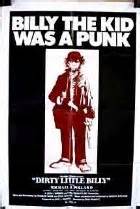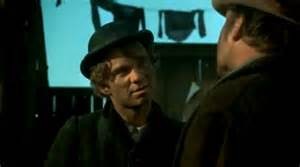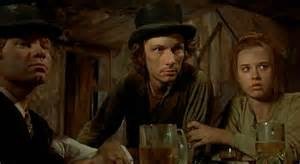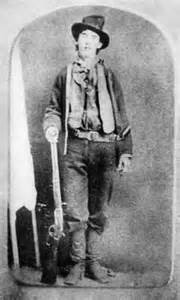Resurrecting “Dirty Little Billy”
 1. Spoiler Alert
1. Spoiler Alert
2. No animals were harmed or confused in the production of this commentary.
3. Author’s cousin will be mentioned in passing.
4. Geezer Subject Matter Warning: Western Films, naked knives, Gary Busey.
Some things treasured but believed lost are still splendid when they’re found or revived. A few nights ago I stayed up late to catch Dirty Little Billy, a gritty, darkly funny western I saw and admired when it first appeared in late 1972 but which, to my disappointment, seemed to vanish from public view like a woodstove dropped into a swamp. The film’s narrative is a highly fictionalized account of Billy Bonney’s first steps from snot-nosed sullen teenager to pistolero, and the source of its fascination for me was twofold: the grimy, shadow- strangled atmosphere of the story’s Kansas railroad-stop village and Michael J. Pollard’s portrayal of William Henry McCarty as a kind of Huck on crack. This film helped shape my appetite and concept of the western, and I have often, while reading or viewing western stories, pined for it.
Most moviegoers recall Pollard from his Academy Award nominated role as C. W. Moss, gas pump monkey/wheelman/sidekick to Bonnie and Clyde in the 1967 Arthur Penn film that launched Warren Beatty and Faye Dunaway into the cinema wowasphere. Pollard’s puckish-punk face and dazzled eyes are enough to make him memorable at a glance, but his shearing laugh and glee over souped-up cars and gunfire cut against the grain of that cartoon grin to stamp him in the mind unforgettably as a lethal innocent.
In Dirty Little Billy, he’s at it again, going from repressed and lethargic teen to ballistic savant in just a few days, or in real time, an hour and a half. The film’s narrative is fairly simple – dragged along a muddy road to a dilapidated farm where the Irish lad’s severe step-father wants to see how quickly Billy’s palms can become huge blisters, he goes AWOL and falls in with Goldie, who — though seemingly only slightly Billy’s senior — terrorizes the town. Now called Billy, instead of Henry McCarty, Pollard joins his mentor hunkered down in Goldie’s stronghold, a ramshackle bar where Goldie’s his girl Berl (perhaps “Beryl” on a clodhopper’s tongue), at the sound of a bell, retreats to a back room where she is repeatedly deflowered for chump change. Along with a couple of unsavory senior citizens, the trio drinks endlessly and sloppily, plays cards against rubes, exudes bile and easy sentiment and engage in sex and often-clownish combat. Eventually the town decides to hire an exterminator. Mayhem follows, with Billy and Goldie escaping to the badlands, where they employ their wiles and Billy’s newfound sharpshooter talent to launch their life as nomadic rogues.

The history of Billy on screen is long and various. Roy Rogers, Johnny Mack Brown and Audie Murphy played him as a misunderstood adolescent or simple maligned hero, Howard Hughes offers Jack Bertel in the role of a wounded and romantic but snake-minded Billy in The Outlaw, a film famous for something other than Billy’s pair of six-shooters. Paul Newman in The Left-Handed Gun rendered Billy (by that stage of his life Bonney, BtK) savvy, more sinned against than sinning and, well, Newman-eyed righteous avenger. There were more Billys in heaven and earth than are dreamt of . . . , and room for a whole gallery of interpretations, but perhaps the death blow to DLB, the product of Charles Moss and Stan Dragoti’s imaginations, was Pat Garrett and Billy the Kid, with its star-peppered cast a far cry from DLB. Singing star Kris Kristofferson is a rangy, mean, charismatic and sexy Billy in this endgame display of B’s long 21-year life, and James Coburn plays assassin/sheriff Pat Garrett, while icons like Slim Pickens, Chill Wills, Jack Elam et alia show up, Rita Coolidge plays B’s paramour “Marie” (really Paulita Maxwell) and one of his henchman, a wise cracker called “Alias,” is played by Robert Zimmerman (aka Dylan, who supplies some of the sound track – “Knockin’ on Heaven’s Door,” for instance). Big budget, Sam Peckinpah in the director’s gurney. I remember loving it in a counter-culture way – just suppose Billy and his pards were like a counter-culture folk music posse, living large and dying hard. . . . And I feel obliged to say that Emilio Estevez’s brat pack and superficially hysterical portrayal of Billy in Young Guns never seemed more than a horse opera, with it’s suggestion that Billy outlived his supposed death to show up years later as ancient Brushy Bill and tell his story. That frame device seemed too transparently lifted from Little Big Man that it didn’t add anything to the inquiry into the nature of Billy and the narrative of his life and “career.”
I’ve seen the Kris/Rita/Bob version four or five times, but it never eclipsed that hour and a half I spent staring at Pollard’s mobile features and hearing his elvish voice. He’s an even five and a half feet tall and comes across as a clown who’s hiding something, a benign naif about to blossom into something truly peculiar amid deep sienna scenery, twisted and cracked planks, scruffy horse-like quadrupeds.
Perhaps a healthier response to DLB would be disgust, but I can’t wash the fascination out of my distaste for the nightmare realism. It doesn’t hurt that Lee Purcell is great as Berl, Richard Evans viable as Goldie and a small cast of helpful “characters,” including Ed Lauter in a small role and an early, not quite complete, teen-mimicking version of Gary Busey, who is already almost all toothy sneer and madness. And Nick Nolte, momentarily.
Why did DLB vanish so quickly and completely? It surely has a lot to do with other westerns released about the same time. The antihero was riding high, and Butch Cassidy and the Sundance Kid brought a new glamor, even beauty, to the category. The Redford/Newman combination was immediately loveable: they were slick and sleek and pretty, mischievous, gallant, witty and naughty. Not real.
For realism, I’ll take the incompetent nightmare post-poker gunfight in a half-lit bar – shadows shoot at shadows, Colts misfire, breakage, screaming, crawling, a drunk bystander the only casualty. Or the knife fight between Berl and the other card sharper’s woman. The two combatant’s slash and jab in a fight that seems unchoreographed skirmish between two snarling doxies who have surely wielded blades before. What stuck with me about this combat was that the director found a middle path between today’s orgy of wounds and blood and the euphemisms of days gone by. The wounds are real enough, but the muted hues and blear prevent Technicolor indulgence typical of that era of Straw Dogs. I have seen fights on and off screen, and this claustrophobic one was one of the most unforgettable and terrifying ones, nothing like the haymakers of the Wayne era or the martial arts of the current scene.
Also high on the realism scale are Billy’s desperation, his yearning for identity, freedom, a voice. He’s a follower looking for something to be proud of it, and grisly as his search is, he finds a self in the end, though one with a short shelf life. All this managed with a humor of action and expression that’s like a dark Harpo thrown in the wilderness. The transitions and juxtapositions are shrewd and ruthless, reminiscent of the Ray Carver of Furious Seasons, before he was Lished into something more marketable, but that’s another story.
In the decades since I first saw the movie I’ve developed an appetite for the western which prosecutes its agenda through atmosphere, tempers its violence with humor and refuses to wallow in either abbatoir splatter or romantic conceit. The necessities of daily survival were taxing, and the temptation to be shifty was stronger than most men and women. I won’t say I could recommend Dirty Little Billy to everyone, but it’s an example of what we now call the “independent film” which offers an alternative fiction where the facts are few and the legends ossified. And surely there’s room for the twisted cherub Pollard embodies in our BtK puzzle.
P.S. on the page, Michael Ondaatje’s The Collected Works of Billy the Kid is worth a look.
The one extant tintype of the notorious BtK, as it is usually seen, with the negative flipped.


